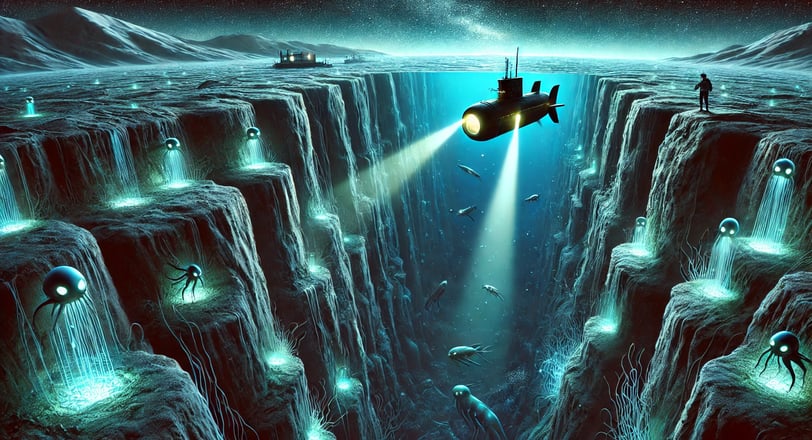The Deepest Holes in the World: Natural, Dug, Terrestrial, and Oceanic
The world is full of impressive geological formations, some created by nature itself and others as a result of human activity. The deepest holes on the planet range from abyssal ocean trenches and natural craters to man-made mines and scientific drillings. Let’s explore these gigantic abysses and understand their formation, dangers, and curiosities.
3/16/20252 min read


The Deepest Natural Holes
1. Mariana Trench - The Deepest Place on Earth
The Mariana Trench, located in the Pacific Ocean, is the deepest known place on Earth. Its deepest point, called Challenger Deep, reaches approximately 10,994 meters in depth. This region has been explored by manned and unmanned submarines, including filmmaker James Cameron’s mission in 2012. Despite these explorations, few have reached the bottom, facing challenges such as extreme pressure and total darkness.
2. Dean’s Blue Hole - The Deepest Underwater Cave
Located in the Bahamas, Dean’s Blue Hole is a blue hole that reaches approximately 202 meters in depth. These holes are formed by the collapse of underground caves and are often explored by divers seeking extreme adventures. Many divers have lost their lives trying to reach its depths due to dangerous conditions such as disorientation and lack of oxygen.
3. Xiaozhai Tiankeng Sinkhole - The Largest Natural Sinkhole
In China, this immense depression is 662 meters deep and about 511 meters in diameter. It was formed by the collapse of underground caves and houses its own ecosystem, with rare species of plants and animals.
The Deepest Man-Made Holes
1. Kola Superdeep Borehole - The Deepest Scientific Drilling
In Russia, scientists drilled the Kola Superdeep Borehole to study the Earth's crust. The drilling reached 12,262 meters in depth, making it the deepest hole ever dug by humans. However, extreme heat made it impossible to continue the project. The site is surrounded by rumors, including stories about mysterious sounds captured from the depths.
2. Mponeng Gold Mine - The Deepest Mine
Located in South Africa, the Mponeng Gold Mine reaches 4,000 meters in depth. Temperatures inside the mine can reach 60°C, making working conditions extremely challenging. Over the years, there have been several accidents, including collapses and underground explosions resulting in loss of life.
3. Big Hole - One of the Largest Open-Pit Mines
The Big Hole diamond mine in South Africa is one of the largest manually dug holes, reaching about 240 meters in depth. It was excavated during the 19th-century diamond rush. Many workers faced harsh conditions, and reports indicate that several miners lost their lives due to collapses.
Accidents, Disappearances, and Extreme Explorations
Missing Divers: In various underwater holes, including Dean’s Blue Hole and the famous "Dragon Hole" in the South China Sea, divers have lost their lives attempting to explore their depths. Some bodies were never recovered due to the inhospitable conditions.
The Mariana Trench Incident: During military tests in the region, some vessels and unmanned submarines were lost due to extreme pressure and structural failures.
Explorations in Mines: In deep mines like Mponeng and the former TauTona Mine, collapses have resulted in worker entrapments, making mining one of the most dangerous jobs in the world.
Dangers and Curiosities
Extreme Pressure: Locations like the Mariana Trench have crushing pressures, making explorations highly challenging.
Collapses: Sinkholes and mines can collapse, posing significant risks.
Legends and Mysteries: Some holes are surrounded by myths. The Kola Borehole, for example, generated rumors of "sounds from hell" being recorded during the drilling.
The deepest holes in the world are a testament to the immense power of nature and human ambition to explore the mysteries of our planet.
Explore
Discover diverse topics in one convenient hub.
Connect
Learn
contact@mindstormblog.com
© 2025. All rights reserved.


